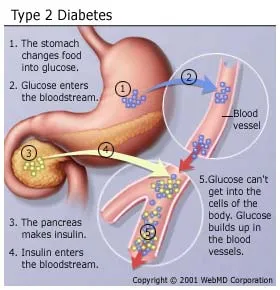Type 2 Diabetes Overview
Type 2 diabetes, often called non-insulin dependent diabetes, is the most common form of diabetes, affecting 90% - 95% of the 21 million people with diabetes. In this article, you'll learn the basics about type 2 diabetes, including symptoms and causes, as well as type 2 diabetes in children.
What Is Type 2 Diabetes?
Unlike people with type 1 diabetes, people with type 2 diabetes produce insulin; however, the insulin their pancreas secretes is either not enough or the body is unable to recognize the insulin and use it properly. This is called insulin-resistance. When there isn't enough insulin or the insulin is not used as it should be, glucose (sugar) can't get into the body's cells. When glucose builds up in the blood instead of going into cells, the body's cells are not able to function properly. Other problems associated with the buildup of glucose in the blood include:
- Dehydration. The buildup of sugar in the blood can cause an increase in urination (to try to clear the sugar from the body). When the kidneys lose the glucose through the urine, a large amount of water is also lost, causing dehydration.
- Diabetic Coma (Hyperosmolar nonketotic diabetic coma). When a person with type 2 diabetes becomes severely dehydrated and is not able to drink enough fluids to make up for the fluid losses, they may develop this life-threatening complication.
- Damage to the body. Over time, the high glucose levels in the blood may damage the nerves and small blood vessels of the eyes, kidneys, and heart and predispose a person to atherosclerosis (hardening) of the large arteries that can cause heart attack and stroke.

Type 2 Diabetes in Children
More and more children are being diagnosed with type 2 diabetes. Find out about type 2 diabetes symptoms in children, the diagnosis, and the treatment in WebMD's article on type 2 diabetes in childhood. If your child is at risk for childhood diabetes, it’s important to learn specific self-care tips to help prevent diabetes.
For more detail, see WebMD's article Type 2 Diabetes in Children.
